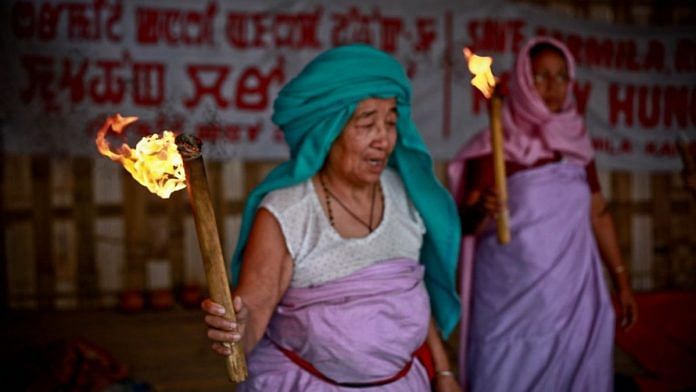Thank you dear subscribers, we are overwhelmed with your response.
Your Turn is a unique section from ThePrint featuring points of view from its subscribers. If you are a subscriber, have a point of view, please send it to us. If not, do subscribe here: https://theprint.in/
Manipur is a state in the northeastern part of India. Although the society and the plains i.e. the valley that the Meiteis, also known as Manipuris, inhabits, is deeply patriarchal, with no traditional inheritance rights for their women on land and immovable assets, its feat in women’s empowerment is no mean task. There is also no denying to the fact that Manipur women are hardly present in the highest echelons of decision making body of the state, to begin with, and the abysmal representation of women legislators in Manipur Legislative Assembly and politics is for all to see, its incredible contribution towards women’s movement has to be told.
In 1904, a strong number of 5000 women of Manipur protested against the British for sending their men to Burma to collect timber. The revolution is said to have lasted for a week and eventually, the British withdrew the new regulation of forced labour. This battle, solely waged by women, later, became the World 1st All Women’s War. Another struggle was waged in 1939 by Manipuri women when there was a man-made famine because of the British policy of exporting rice outside Manipur. The struggle is said to have lasted for several months, with women out on the roads, eventually claiming a few lives of the women protestors. The agitation subsided because of the outbreak of the 2nd World War. Both these historic war came to be known as the 1st and 2nd Nupi Lal or Women’s War. The all women civilian troops protested against the British for their policy of forced labour and exploitation of their men in 1904 and against the price hike and scarcity of rice because of the exportation in 1939. This was significant as women of Manipur were on the forefront of every repressive laws made by the British imperialists.
Another interesting fact is that the largest All Women’s Market in Asia is run by the Manipur women in Imphal, which is the capital city of Manipur. What is significant is that not only it provides economic empowerment to the estimated 5000-6000 women vendors that sells everything from handloom, handicrafts, fruits to items of daily necessities, these Manipur women slays it by the owning the workplace too. The All Women’s Market in Manipur, also known as Nupi Keithel meaning Women’s Market, which was established in the 16th century, and have survived and flourished till date, has an immensely intriguing history that showed that these women had to fend and provide for themselves while their men goes for lallup-kaba, which was forced labour imposed by the then Manipur king that required the men to go distant places to work or serve in the military.
Also, the women’s activism and protest movement in independent India came in the form of Nisha Bandh and Meira Paibis in Manipur, wherein, in the first case,i.e. Nisha Bandh- the Manipur women were out on the street at night patrolling against men who consume intoxicants and abuse drugs. These women vigilante activists were a dominant force for Manipur men to stay off the streets at night after consuming alcohol and other intoxicants. The Nisha Bandh vigilante activists women is pioneer in its approach towards creating a sense of fear among men who would, otherwise, cause ruckus in inebriated state in public spaces.
The Meira Paibis, literally translated as women torch bearers in Manipuri, on the other hand, is a Manipur women’s protest movement group that fights against the state for their failure to provide redressal for human rights violations and crimes against women, among others.
What is significant about these protests movement is that even today, Manipur women are always out on the streets protesting against the excesses of the state as well as injustices meted out women.
These pieces are being published as they have been received – they have not been edited/fact-checked by ThePrint.
Also read: Outbreak of African Swine Fever in Mizoram, Sikkim & Assam, states restrict import of pigs

